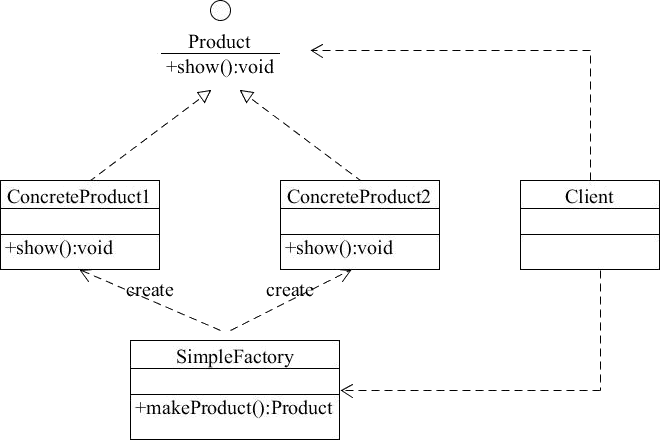java 设计模式:简单工厂
工厂模式的定义
定义一个创建产品对象的工厂接口,将产品对象的实际创建工作推迟到具体子工厂类当中。这满足创建型模式中所要求的“创建与使用相分离”的特点。
简单工厂
如果要创建的产品不多,只要一个工厂类就可以完成,这种模式叫“简单工厂模式”。
简单工厂通常为静态方法,因此又叫静态工厂方法模式
优点:
- 工厂类包含必要的逻辑判断,可以决定在什么时候创建哪一个产品的实例。客户端可以免除直接创建产品对象的职责,很方便的创建出相应的产品。工厂和产品的职责区分明确。
- 客户端无需知道所创建具体产品的类名,只需知道参数即可。
也可以引入配置文件,在不修改客户端代码的情况下更换和添加新的具体产品类。
缺点:
- 简单工厂模式的工厂类单一,负责所有产品的创建,职责过重,一旦异常,整个系统将受影响。且工厂类代码会非常臃肿,违背高聚合原则。
- 使用简单工厂模式会增加系统中类的个数(引入新的工厂类),增加系统的复杂度和理解难度
- 系统扩展困难,一旦增加新产品不得不修改工厂逻辑,在产品类型较多时,可能造成逻辑过于复杂
- 简单工厂模式使用了 static 工厂方法,造成工厂角色无法形成基于继承的等级结构。
应用场景
对于产品种类相对较少的情况,考虑使用简单工厂模式。使用简单工厂模式的客户端只需要传入工厂类的参数,不需要关心如何创建对象的逻辑,可以很方便地创建所需产品。
代码实现
简单工厂模式的主要角色如下:
- 简单工厂:是简单工厂模式的核心,负责实现创建所有实例的内部逻辑。工厂类的创建产品类的方法可以被外界直接调用,创建所需的产品对象。
- 抽象产品:是简单工厂创建的所有对象的父类,负责描述所有实例共有的公共接口。
- 具体产品:是简单工厂模式的创建目标。
其结构图如下图所示。

kotlin代码实现
interface IProduct{
fun showName() :String
}
class Dog : IProduct{
override fun showName() = "dog"
}
class Cat : IProduct{
override fun showName() = "cat"
}
object AnimalFactory{
fun createAnimal(type:Int):IProduct{
return when(type){
1-> Dog()
2-> Cat()
else -> throw NullPointerException()
}
}
}
简单工厂模式在Android中的实际应用
fragment 的构建
有时候,为了简化简单工厂模式,我们可以将抽象产品类和工厂类合并,将静态工厂方法移至抽象产品类中。Fragment的创建使用简单工厂方法没有抽象产品类,所以工厂类放到了实现产品类中。
class ListWorkFragment : BMvpFragment<ListWorkView ,ListWorkPresenter>(),ListWorkView,ISubjectView{
companion object {
@JvmStatic
fun newInstance(recommendTypeId: Int,
termCode: String = "") =
ListWorkFragment().apply {
arguments = Bundle().apply {
putInt("type", recommendTypeId)
putString("code", termCode)
}
}
}
优点
- 在创建Fragment的时候,可以不需要管内部参数,而从外部输入
- Fragment推荐使用setArguments来传递参数,避免在横竖屏切换的时候Fragment自动调用自己的无参构造函数,导致数据丢失。
Bitmap源码分析
@UnsupportedAppUsage(maxTargetSdk = 28)
Bitmap(long nativeBitmap, int width, int height, int density,
boolean requestPremultiplied, byte[] ninePatchChunk,
NinePatch.InsetStruct ninePatchInsets) {
this(nativeBitmap, width, height, density, requestPremultiplied, ninePatchChunk,
ninePatchInsets, true);
}
// called from JNI and Bitmap_Delegate.
Bitmap(long nativeBitmap, int width, int height, int density,
boolean requestPremultiplied, byte[] ninePatchChunk,
NinePatch.InsetStruct ninePatchInsets, boolean fromMalloc) {
...
}
看构造函数可知,无法new出bitmap,那么怎么创建bitmap对象呢?
BitmapFactory.decodeFile("")
内部源码
public static Bitmap decodeFile(String pathName) {
return decodeFile(pathName, null);
}
public static Bitmap decodeFile(String pathName, Options opts) {
Bitmap bm = null;
InputStream stream = null;
try {
stream = new FileInputStream(pathName);
bm = decodeStream(stream, null, opts);
} catch (Exception e) {
/* do nothing.
If the exception happened on open, bm will be null.
*/
Log.e("BitmapFactory", "Unable to decode stream: " + e);
} finally {
if (stream != null) {
try {
stream.close();
} catch (IOException e) {
// do nothing here
}
}
}
return bm;
}
public static Bitmap decodeStream(InputStream is, Rect outPadding, Options opts) {
// we don't throw in this case, thus allowing the caller to only check
// the cache, and not force the image to be decoded.
if (is == null) {
return null;
}
Bitmap bm = null;
Trace.traceBegin(Trace.TRACE_TAG_GRAPHICS, "decodeBitmap");
try {
if (is instanceof AssetManager.AssetInputStream) {
final long asset = ((AssetManager.AssetInputStream) is).getNativeAsset();
bm = nativeDecodeAsset(asset, outPadding, opts);
} else {
bm = decodeStreamInternal(is, outPadding, opts);
}
if (bm == null && opts != null && opts.inBitmap != null) {
throw new IllegalArgumentException("Problem decoding into existing bitmap");
}
setDensityFromOptions(bm, opts);
} finally {
Trace.traceEnd(Trace.TRACE_TAG_GRAPHICS);
}
return bm;
}
private static native Bitmap nativeDecodeStream(InputStream is, byte[] storage,
Rect padding, Options opts);
/**
* Set the newly decoded bitmap's density based on the Options.
*/
private static void setDensityFromOptions(Bitmap outputBitmap, Options opts) {
if (outputBitmap == null || opts == null) return;
final int density = opts.inDensity;
if (density != 0) {
outputBitmap.setDensity(density);
final int targetDensity = opts.inTargetDensity;
if (targetDensity == 0 || density == targetDensity || density == opts.inScreenDensity) {
return;
}
byte[] np = outputBitmap.getNinePatchChunk();
final boolean isNinePatch = np != null && NinePatch.isNinePatchChunk(np);
if (opts.inScaled || isNinePatch) {
outputBitmap.setDensity(targetDensity);
}
} else if (opts.inBitmap != null) {
// bitmap was reused, ensure density is reset
outputBitmap.setDensity(Bitmap.getDefaultDensity());
}
}
看下BitmapFactory的注释我们可以看到,这个工厂支持从不同的资源创建Bitmap对象,包括files, streams, 和byte-arrays,但是调用关系都大同小异。
